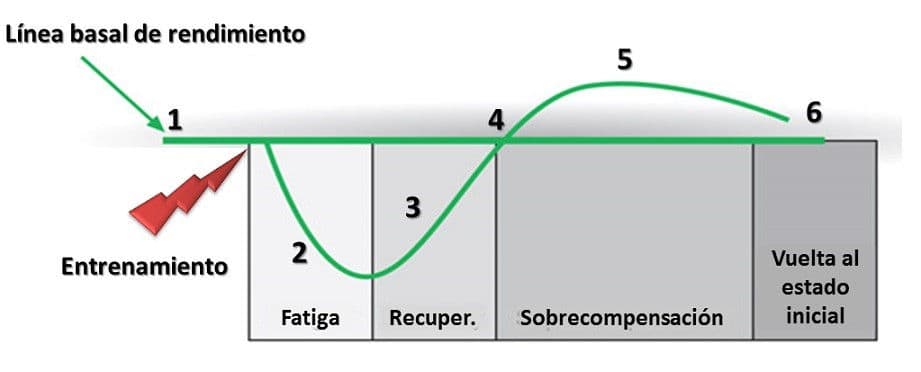Imagine that your body is like a race car: to achieve maximum performance, it needs both full throttle acceleration and pit stops. This is where the deload week comes into play, a crucial technique in physical and mental training. But what exactly does it consist of?
What is a deload week?
The Deload Week is a strategy used in physical and sports training, which involves temporarily reducing the intensity and volume of exercise.
This technique is essential to avoid overtraining and promote adequate recovery, favoring supercompensation.
During a deload week, athletes and people who regularly engage in physical exercises decrease their workload, which may include reducing the weight lifted, the distance covered, the duration of the exercise, or the overall intensity of training sessions.
The main goal of a deload week is to allow the body to recover from the accumulated stresses during periods of intensive training. This recovery is crucial for improving long-term performance, reducing the risk of injuries, and maintaining optimal physical and mental well-being.
During a deload week, activities may include lower-intensity exercises, stretching sessions, yoga, light recreational activities, or simply rest.
This does not mean that all physical activity stops, but rather it is modified to allow the body and mind to recover effectively.
Incorporating deload weeks into a training program helps maintain a healthy balance between effort and recovery, ensuring that training is sustainable and effective in the long term.
Benefits of incorporating a deload week into your training
Integrating deload weeks into your training routine offers multiple benefits for both your physical performance and your mental and overall health. Here are some of the most notable benefits:
- Injury prevention: By periodically reducing the intensity and volume of training, you decrease the risk of injuries related to overtraining, such as muscle tears or joint problems.
- Improvement in muscle recovery: Deload weeks give your muscles the necessary time to repair and strengthen, which is crucial for muscle development and performance improvement.
- Optimization of sports performance: By allowing your body to rest adequately, you can return to your regular training with more energy and capacity, resulting in better performance.
- Maintenance of motivation: Avoiding the monotony of constant training and allowing yourself a break can help maintain high levels of motivation and commitment to your fitness goals.
- Improvement of mental and emotional state: The reduction of physical stress also positively impacts your mental well-being, reducing the risk of burnout and improving your mood and concentration.
- Stress and fatigue management: Deload weeks help manage accumulated stress and fatigue, which is vital for the balance between training, rest, and recovery.
- Increase in training adaptation: This period allows your body to better adapt to training loads, leading to more significant improvements over time.
- Better sleep quality: With a reduced training load, many find an improvement in their sleep quality, which is fundamental for overall recovery and performance.
Including deload weeks in your training planning is a smart and effective strategy to achieve a healthy balance, maximize your results, and take care of your physical and mental health in the long term.
What are the characteristics of a deload week?
A well-structured deload week has several key characteristics that differentiate it from regular training weeks.
These characteristics are designed to maximize recovery while keeping the body active. Here are some of the most important ones:
- Reduction of intensity: During a deload week, the intensity of training is significantly reduced. This could mean lifting less weight, running at a slower pace, doing fewer repetitions, or decreasing resistance in cardiovascular exercises.
- Decrease in training volume: In addition to reducing intensity, the total training volume also decreases. This involves doing fewer sets, fewer repetitions, or shortening the duration of each training session.
- Maintenance of training frequency: Despite the reduction in intensity and volume, the training frequency (how many times per week you train) is often maintained. This helps preserve the routine and habit of exercise.
- Focus on low-impact activities: The inclusion of low-impact activities such as yoga, swimming, walking, or gentle cycling is preferred. These activities help keep the body moving without exerting excessive strain.
- Incorporation of recovery techniques: During this week, priority is given to recovery techniques such as stretching, mobility, hydrotherapy, massages, or the use of foam rollers.
- Attention to the body’s response: It is essential to listen to the body during a deload week. Activities and intensity should be adjusted according to how the body feels day by day.
- Mental and emotional focus: The deload week is also a time to recover mentally and emotionally from the stress of intense training, so practices like mindfulness, meditation, or simply leisure and relaxation activities can be included.
- Preparation for the next training cycle: The deload week also serves as a preparation period for the next training cycle, allowing the body and mind to be ready to take on new challenges.
In summary, a deload week is an essential component of any well-balanced training program. It allows the body to recover, prevents overtraining, and contributes to sustained long-term performance.
How to plan a deload week?
Planning a deload week in strength training requires a careful approach and an understanding of how to effectively reduce the workload while keeping the body active and preparing for the next training cycle.
Here is how you can do it:
1. Prior assessment
Before starting the deload week, assess your level of fatigue, performance, and any signs of overtraining. This will help you determine the necessary reduction in your training.
2. Planning volume and intensity
- Weight reduction: Decrease the weights lifted to between 40% and 60% of your usual maximum. If you normally lift 100 kg in an exercise, during the deload week, reduce to 40-60 kg.
- Reduction of sets and repetitions: Decrease the number of sets and repetitions. For example, if you do 4 sets of 10 repetitions, reduce to 2-3 sets of 6-8 repetitions.
3. Exercise selection
- Prioritize basic compound exercises (such as squats, bench press, deadlift) with impeccable technique but with less weight.
- Include accessory movements that promote mobility and control, such as dynamic stretches or exercises with resistance bands.
4. Training frequency
- Maintain your usual training frequency, but with shorter and less intense sessions.
5. Focus on recovery
- Include active recovery techniques such as yoga, stretching, or light walks.
- Consider massage sessions or foam roller therapy to aid in muscle recovery.
6. Nutrition and hydration
- Maintain a balanced diet rich in proteins, carbohydrates, and healthy fats.
- Ensure you hydrate adequately to facilitate muscle recovery.
7. Sleep monitoring
- Prioritize quality sleep, aiming to sleep between 7-9 hours per night.
8. Attention to body signals
- Pay attention to how your body feels during this week. If you feel particularly fatigued or sore, it’s okay to reduce the intensity even further.
9. Preparation for the next cycle
- Use this week to plan your next training cycles, setting new goals and adjustments in your program.
10. Post-deload evaluation
- At the end of the deload week, evaluate how you feel. You should feel more recovered, less fatigued, and ready to resume more intense training.
Additional tips:
- Avoid training to failure: During the deload week, avoid taking your muscles to failure.
- Technique over intensity: Focus on maintaining perfect technique rather than the amount of weight lifted.
- Positive mindset: Maintain a positive attitude towards the deload week, remembering that it is an essential component for long-term progress.
Planning an adequate deload week is as important as intense training. It allows you to recover, prevent injuries, and return to the gym with renewed energy and strength.
How long should a deload week last?
A deload week, as its name suggests, generally lasts a full week, that is, the same time that a regular training cycle would normally take. This period of time is ideal for several reasons:
- Consistency with training cycles: Most training programs are structured in weekly cycles. Maintaining the deload for a full week allows for smooth integration with these cycles.
- Enough time for recovery: A week provides the necessary time for the body to recover from the accumulated stresses during more intense training weeks.
- Facilitates planning and habit: Having a fixed and predictable duration for the deload week helps maintain a routine and facilitates the planning of future training.
- Psychological adaptation: A week is generally enough for you to mentally adapt and prepare for the next intensive training cycle.
However, it is important to note that the duration of a deload week may vary slightly depending on individual factors such as the level of fatigue, the type of training being performed, and personal responses to exercise.
[article ids=”8216″] In some cases, especially in high-intensity training or elite athletes, it may be appropriate to extend the deload to more than a week to ensure complete recovery.
The key is to listen to your body and adjust the duration of the deload week according to your individual needs and training goals.







